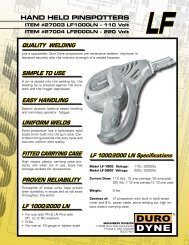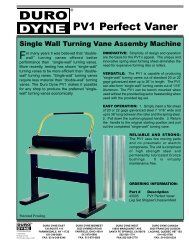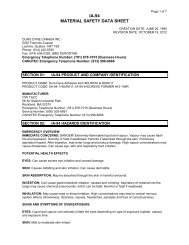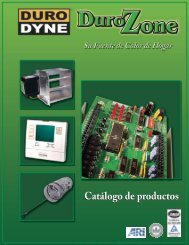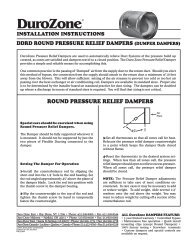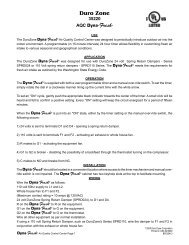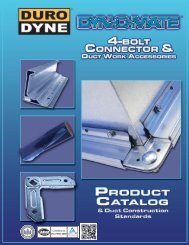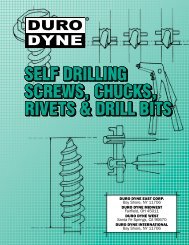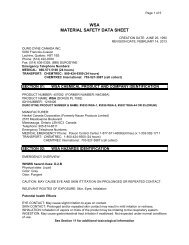PAW40 MSDS - Duro Dyne
PAW40 MSDS - Duro Dyne
PAW40 MSDS - Duro Dyne
You also want an ePaper? Increase the reach of your titles
YUMPU automatically turns print PDFs into web optimized ePapers that Google loves.
SAFETY DATA SHEETPrepared by <strong>Duro</strong> <strong>Dyne</strong> December 20, 2013HEALTH 1FLAMMABILITY 0REACTIVITY 1SPECIAL HAZARD NONE1. CHEMICAL PRODUCT AND COMPANY IDENTIFICATIONTrade name:DURO DYNE ADHESIVEProduct Identifier: <strong>PAW40</strong> (LEED Compliant)Item #: 5091Supplier Details: DURO DYNE CORPORATION81 Spence StreetBay Shore, NY 11706InformationPhone No: 800-899-3876EmergencyPhone No:2. HAZARDS IDENTIFICATIONS800-424-9300 (CHEMTREC)2.1 Emergency Overview:Immediate Health, Physical andEnvironmental Hazards:2.2 Potential Health Effects:Eye Contact:Skin Contact:Inhalation:Ingestion:Closed containers exposed to heat from fire may buildpressure and explode.Mild Eye Irritation: Signs/symptoms may includeredness, swelling, pain, tearing, and blurred or hazyvision.Mild Skin Irritation: Signs/symptoms may includelocalized redness, swelling, itching, and dryness.Respiratory Tract Irritation: Signs/symptoms mayinclude cough, sneezing, nasal discharge, headache,hoarseness, nose and throat and pain.Gastrointestinal Irritation: Signs/symptoms may includeabdominal pain, stomach upset, nausea, vomiting anddiarrhea.3. COMPOSITION/INFORMATION ON INGREDIENTSINGREDIENT C.A.S. No. % by Wt.Acrylic Polymer Not Determined 65-751,1,1,2-Tetrafluoroethane 811-97-2
4. FIRST AID MEASURES4.1 First Aid ProceduresThe following first aid recommendations are based on an assumption that appropriatepersonal and industrial hygiene practices are followed:Eye Contact:Skin Contact:Inhalation:If Swallowed:Flush eyes with large amounts of water. Ifsigns/symptoms persist, get medical attention.Remove contaminated clothing and shoes. Immediatelyflush skin with large amounts of water. Get medicalattention. Wash contaminated clothing and clean shoesbefore reuse.Remove person to fresh air. If signs/symptoms develop,get medical attention.Do not induce vomiting unless instructed to do so bymedical personnel. Give victim two glasses of water.Never give anything by mouth to an unconsciousperson. Get medical attention.5. FIRE FIGHTING MEASURES5.1 Flammable PropertiesFlammability:Auto ignition Temperature:Flash Point:Flammable Limits-LEL:Flammable Limits-UEL:Non-Flammable per industry standard flame projectiontest.>743ºC (>1369ºF)NoneNoneNone5.2 Extinguishing Media: Use fire extinguishers with class B extinguishing agents(e.g., dry chemical, carbon dioxide).5.3 Protection of Fire Fighters:Special Fire Fighting Procedures:Unusual Fire and Explosion Hazards:Firefighters and other exposed to vapors should wearself-contained breathing apparatus.Water spray may be used for cooling to preventpossible pressure build-up when exposed to extremeheat.6. ACCIDENTAL RELEASE MEASUREPage 2 of 5
Accidental Release Measures:Evacuate non-essential personnel. Ventilate the area.Dike around spilled material. Collect material inapproved containers, and dispose of in accordance withlocal, state and federal laws and regulations. For SmallQuantities: Mop up or absorb inert material and place incontainers.7. HANDLING AND STORAGE7.1 Handling: Do not eat, drink or smoke when using this product.Wash exposed areas thoroughly with soap and water.Avoid eye contact with vapors, mists, or spray. Keepout of reach of children. Use general ventilation. Ifventilation is not adequate, use respiratory protectionequipment.7.2 Storage: Store away from acids. Store away from heat. Store outof direct sunlight. Keep container tightly closed. Storeaway from oxidizing agents. Keep from freezing.8. EXPOSURE CONTROLS / PERSONAL PROTECTION8.1 Engineering Controls: Use with appropriate local exhaust ventilation. Usegeneral ventilation and/or local exhaust ventilation or ifventilation is not adequate, use protection equipment.8.2 Personal ProtectiveEquipment (PPE):Eye/Face Protection:Skin Protection:Respiratory Protection:Prevention of Swallowing:Avoid eye contact with vapors, mists or spray. Thefollowing eye protection(s) are recommended: SafetyGlasses.Avoid skin contact. Select and use gloves and/orprotective clothing to prevent skin contact based on theresults of an exposure assessment. Gloves made fromthe following material(s) are recommended: PolyvinylAlcohol (PVA), Polyethylene/Ethylene Vinyl Alcohol.Avoid breathing of vapors, mists or spray.Do not eat, drink or smoke when using this product.Wash exposed areas thoroughly with soap and water.8.3 Exposure Guidelines: Ingredient: 1,1,1,2-TetrafluoroethaneAuthority: AIHAType: TWALimit: 1000 ppmPage 3 of 5
Sources of Exposure Limit Data:AIHA: American Industrial Hygience AssociationWorkplace Environmental Exposure Level (WEEL)9. PHYSICAL AND CHEMICAL PROPERTIESOdor, Color:Typical acrylic odor, white color.Boiling Point:-15ºF (-26ºC)Vapor Density:Not DeterminedVapor Pressure:Not DeterminedSpecific Gravity:1.00 to 1.04 gms/cc (8.3 to 8.7 lbs/gal)Solubility in Water:SolublePercent Volatile:



